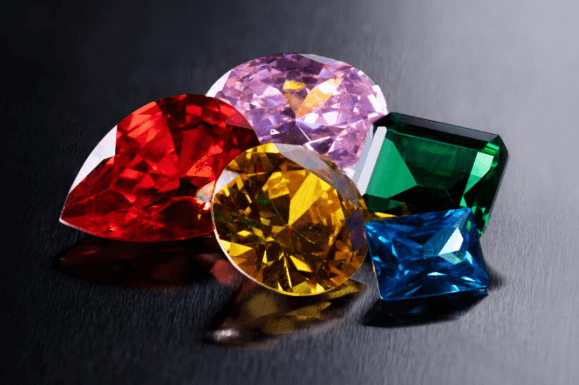The Science Behind Birthstones: What Makes Each Gem Unique

Birthstones have long captured our imaginations, symbolising everything from personal identity to ancient beliefs. But what makes each birthstone truly unique goes beyond its colour and beauty. Let’s delve into the fascinating science behind these gems and uncover the secrets of what makes each one so special.
The Science Behind Each Birthstone
January – Garnet:
Garnets are a group of silicate minerals, and their colour ranges from deep red to green, depending on their composition. For instance, pyrope garnets are known for their fiery red hues, while tsavorite garnets display a vibrant green due to the presence of chromium. Check out beautiful birthstone jewellery at gaamaa.com.
February – Amethyst:
Amethyst, a variety of quartz, gets its purple colour from iron and irradiation. The intensity of its colour can vary, with some stones exhibiting a more vivid hue due to higher levels of iron.
See also: Birthday Gifts for Mom from Her Son: A Guide to Making Her Day Truly Special
March – Aquamarine:
Aquamarine is a blue variety of beryl, the same family as emeralds. Its soothing blue colour is the result of trace amounts of iron within the crystal structure. The gem’s clarity and light blue to greenish-blue hues make it a popular choice.
April – Diamond:
Diamonds are renowned for their unmatched hardness, ranking 10 on the Mohs scale. They are composed of carbon atoms arranged in a crystal lattice, which gives them their incredible brilliance and durability.
May – Emerald:
Emeralds are known for their rich green colour, which is primarily due to the presence of chromium. These stones often have inclusions, known as “jardin,” which can affect their clarity but also add to their unique character.
June – Pearl and Alexandrite:
Pearls are organic gemstones formed within mollusks and come in a variety of colours and shapes. Alexandrite, on the other hand, is a rare gemstone known for its remarkable colour-change ability, shifting from green to red depending on the lighting.
July – Ruby:
Rubies are a variety of corundum, the same mineral group as sapphires. Their red colour is attributed to chromium. Rubies are prized for their vibrant red hues and rarity, making them one of the most valuable gemstones.
August – Peridot:
Peridot, a green gemstone, is formed from olivine and gets its colour from iron. Its vibrant green hue and relative affordability make it a popular choice for jewellery.
September – Sapphire:
While sapphires are most commonly associated with a deep blue colour, they actually come in a variety of hues. The presence of different trace elements, such as iron or titanium, can produce colours ranging from pink to yellow.
October – Opal and Tourmaline:
Opals are unique due to their play-of-colour, a phenomenon caused by the diffraction of light within their internal structure. Tourmaline, on the other hand, exhibits a wide range of colours, thanks to its complex crystal structure and the presence of various elements.
November – Topaz and Citrine:
Topaz and citrine are both varieties of quartz. Topaz can range in colour from blue to pink, while citrine is known for its warm yellow to orange hues. The colour differences are due to variations in their mineral content and treatment processes.
December – Turquoise, Tanzanite, and Zircon:
Turquoise is an opaque gemstone with a distinctive blue to green colour, formed from copper and aluminium. Tanzanite is a blue to violet variety of zoisite, known for its vibrant hues and rarity. Zircon, often confused with synthetic cubic zirconia, comes in a variety of colours and is prized for its brilliance.
Tips for Choosing the Perfect Ring
Would you like to add a ring to your jewellery collection? If this isn’t an accessory you normally wear and you’re trying to branch out, you might not know where to begin. There are so many different styles available, whether you want an open ring or a stacking design. Indeed, having so many choices on the internet can leave you feeling overwhelmed. Here are some tips that are going to help you narrow down your options and find the perfect ring.
Choose Your Budget
First of all, realise that you can get cheap rings, as well as very expensive ones. If you don’t have a budget from the beginning, you can get lost in the choice. Decide how much you want to spend. Then, you can use this filter online to avoid disappointment and from choosing something outwith this number.
Understand the Material
There are various materials available for rings, which can affect their style and durability. Some people love the look of gold-plated and how it fits their budget. Others prefer Sterling Silver for its shine and durability. You need to understand what the material can offer before you buy it. This allows you to select a ring that’s suitable for your lifestyle.
Check the Thickness
Of course, you want to choose a ring that you find attractive and wish to wear. The design should be appealing and suit the event you’re going to or the situation you’ll be wearing it in. But, you should also pay attention to the thickness of the ring. When you have a thick ring, that can make it uncomfortable for some people. You want to be able to wear the ring all day without having any issues.
Conclusion
Understanding the science behind birthstones adds a new layer of appreciation for these beautiful gems. From their formation and unique properties to the technology behind synthetic stones, each aspect contributes to the allure of birthstones. Next time you admire a piece of birthstone jewellery, remember the fascinating science that makes it so unique.
